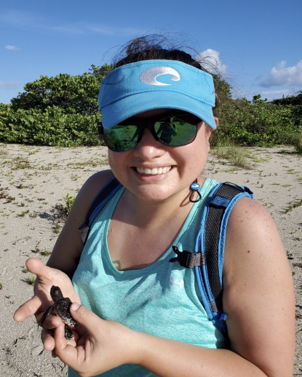Carmen Rodriguez

- Born in Lima, Peru, Carmen moved to the US when she was 18 and enrolled at NSU to pursue her career. Under the guidance of professors such as Dr. Messing, Dr. Keith, Dr. Hirons, and other she was able to build up knowledge on manatee health assessments, deep sea corals, stable isotope analysis on marine mammals, and her favorite, field work.
- Carmen has previously served as a museum coordinator, sea turtle surveyor with the Broward County Sea Turtle Conservation Program, and Marine Permit Holder for the Museum of Discovery and Science.
- Carmen also led the orchid propagation lab while working for FAU’s Pine Jog Environmental Education Center where she expanded their reach in growing over 14 different species of native orchids for restoration purposes by collaborating with county, state, and federal agencies.
Vaudo, J.J. and M.R. Heithaus. (2013) Microhabitat selection by marine mesoconsumers in a thermally heterogeneous habitat: behavioral thermoregulation or avoiding predation risk? PLoS ONE 8(4): e61907. doi:10.1371/journal.pone.0061907.
Heithaus, M.R., J.J. Vaudo, S. Kreicker, C.A. Layman, M. Krützen, D.A. Burkholder, K. Gastrich, C. Bessey, R. Sarabia, K. Cameron, A. Wirsing, J.A. Thomson and M.M. Dunphy-Daly (2013) Apparent resource partitioning and trophic structure of large-bodied marine predators in a relatively pristine seagrass ecosystem. Mar. Ecol. Prog. Ser. 481: 225-237.
Vaudo, J.J. and M.R. Heithaus (2012) Diel and seasonal variation in the use of a nearshore sandflat by a ray community in a near pristine system. Mar. Fresh. Res. 63: 1077-1084.
Layman, C.A., M.S. Araujo, R Boucek, C.M. Hammerschlag-Peyer, E. Harrison, Z.R. Jud, P. Matich, A.E. Rosenblatt, J.J. Vaudo, L.A. Yeager, D.M. Post, and S. Bearhop (2012) Applying stable isotopes to examine food web structure: an overview of analytical tools. Biol. Rev. 87: 545-562.
Thomson, J.A., M.R. Heithaus, D.A. Burkholder, J.J. Vaudo, A.J. Wirsing and L.M. Dill (2012) Site specialists, diet generalists? Isotopic variation, site fidelity and foraging by loggerhead turtles in Shark Bay, Western Australia. Mar. Ecol. Prog. Ser. 453: 213-226.
Heithaus, M.R.and J.J. Vaudo (2012) Predator-prey interactions. In: Carrier, J.C., Musick, J., and Heithaus, M.R. (Eds), The Biology of Sharks and Their Relatives. 2nd ed. CRC Press, Boca Raton, FL, pp. 505-546.
Vaudo, J.J. and M.R. Heithaus (2011) High-trophic-level consumers: elasmobranchs. In: Wolanski, E., McLusky, D. (Eds), Treatise on Estuarine and Coastal Science, Vol 6. Waltham: Academic Press. pp. 203-225.
Vaudo, J.J. and M.R. Heithaus (2011) Dietary niche overlap in a nearshore elasmobranch mesopredator community. Mar. Ecol. Prog. Ser. 425: 247-260.
Vaudo, J.J., P. Matich P. and M.R. Heithaus (2010) Mother–offspring isotope fractionation in two species of placentatrophic sharks. J Fish Biol 77: 1724-1727.
Heithaus, M.R., A. Frid, J.J. Vaudo, B. Worm and A.J. Wirsing (2010) Unraveling the ecological importance of elasmobranchs. In: Carrier, J.C., Musick, J.A., Heithaus, M.R. (Eds), Sharks and Their Relatives II: Biodiversity, Adaptive Physiology, and Conservation. CRC Press, Boca Raton, FL, pp. 607-633.
Vaudo, J.J. and M.R. Heithaus (2009) Spatiotemporal variability in a sandflat elasmobranch fauna in Shark Bay, Australia. Mar. Biol. 156: 2579–2590.
Lowe, C.G., G.J. Moss, G. Hoisington, J.J. Vaudo, D.P. Cartamil, M.M. Marcotte, and Y.P. Papastamatiou (2007) Caudal Spine Shedding Periodicity and Site Fidelity of Round Stingrays, Urobatis halleri (Cooper), at Seal Beach, California: Implications for Stingray-related Injury Management. Bull. Southern Calif. Acad. Sci. 106: 16-26.
Vaudo, J.J. and C.G. Lowe (2006) Movement patterns of the round stingray, Urobatis halleri (Cooper), near a thermal outfall. J. Fish. Biol. 68: 1756-1766.
Cartamil, D.P., J.J. Vaudo, C.G. Lowe, B.M. Wetherbee, and K.N. Holland (2003) Diel movement patterns of the Hawaiian stingray, Dasyatis lata: implications for resource partitioning between sympatric elasmobranch species. Mar. Biol. 142: 841-847.